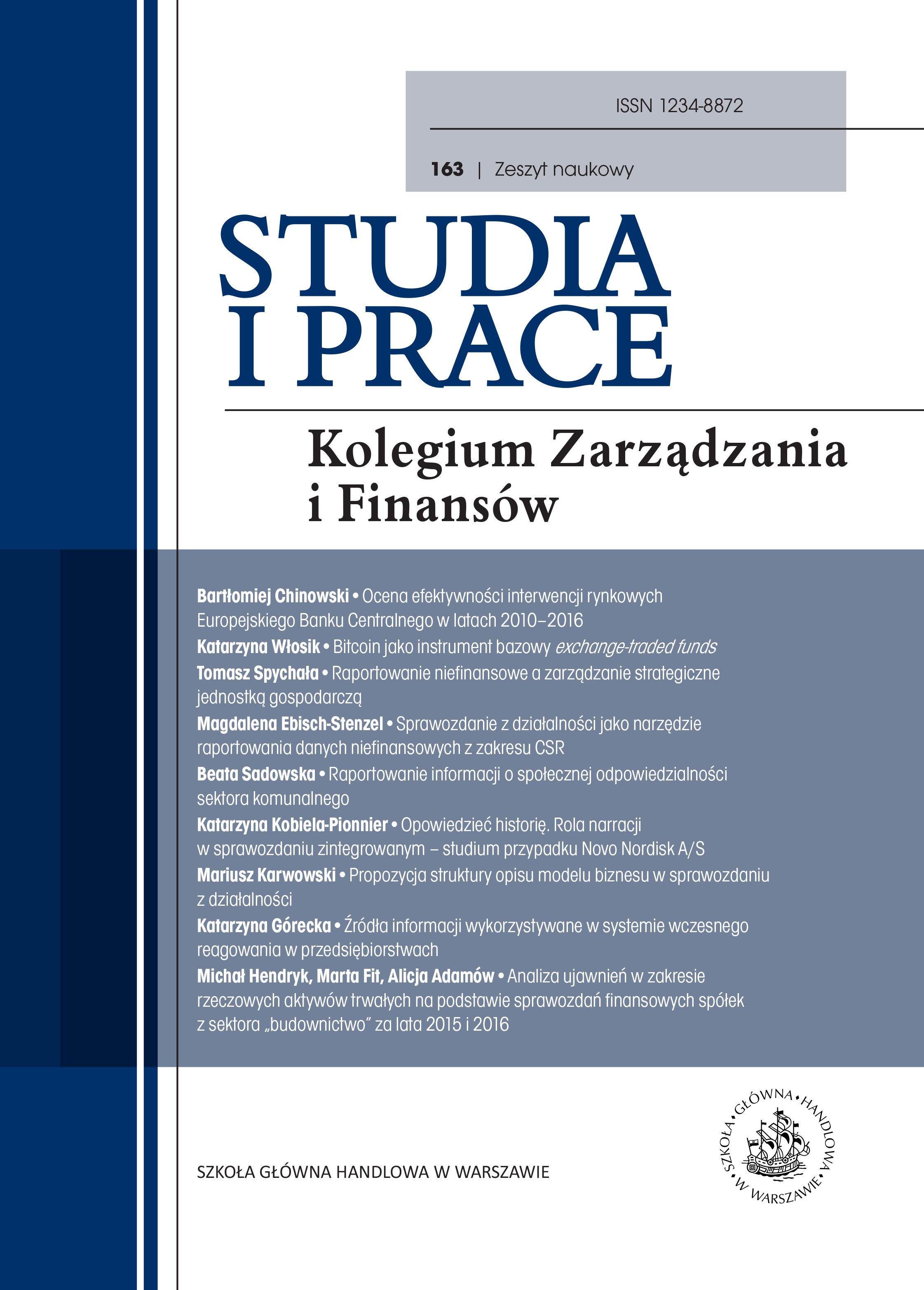Assessment of Effectiveness of Market Interventions of the European Central Bank in the years 2010–2016
DOI:
https://doi.org/10.33119/SIP.2018.163.1Keywords:
central bank, EBC programmes, post-crisis activities, information policyAbstract
The article is aimed at the analysis of the impact of the post-crisis interventions made by the European Central Bank in the years 2010–2016. The analysis refers to the aid programmes actually implemented in favour of banks and governments of the indebted EU countries as well as the information policy concerning the programmes announced but not implemented so far. On the basis of the quotation of domestic credit risk swaps (CDS) and the credit action dynamics the impact of the analysed aid programmes on the real sphere of the economy was assessed. The observations indicate that interventions were effective as after they were introduced, the events that the Bank wanted to prevent did not take place. At the same time, no negative effects of the discussed programmes were explicitly confirmed. A relatively high effectiveness of the information policy of Central Bank was observed in comparison with expensive intervention programmes. Thus, it was found that the EBC activities within the discussed scope brought the intended effects and may be regarded effective.
Downloads
References
2. Acharya V., Lender of Last Resort versus Buyer of Last Resort – Evidence from the European Sovereign Debt Crisis, „Centre for European Economic Research Discussion Paper” 2016, no. 16–19.
3. Altavilla C. et al., The Financial and Macroeconomic Effects of OMT Announcements, ECB Working Paper 2014, no. 1707.
4. Bank of England, Annual Report 2007, 2008.
5. Daetz S., Subrahmanyam M. et al., Did ECB Liquidity Injections Help the Real Economy?, New York University, New York 2016.
6. De Grauwe P., The European Central Bank as Lender of Last Resort in the Government Bond Markets, „CESifo Economic Studies” 2013, vol. 59, 3..
7. ECB, Statement of the Governing Council Following the Start of Military Action in Iraq, 2003.
8. ECB, Technical Features of Outright Monetary Transactions, 6 September 2012.
9. ESRB, ESRB Report on the Regulatory Treatment of Sovereign Exposures, 2015.
10. Fratzscher M. et al., ECB Unconventional Monetary Policy: Market Impact and International Spillovers, „IMF Economic Review” 2016, vol. 64, no. 1.
11. Georgiadis G., Gräb J., Global Financial Market Impact of the Announcement of the ECB's Extended Asset Purchase Programme, Federal Reserve Bank of Dallas, Globalization and Monetary Policy Institute Working Papers 2015, 232.
12. Ghysels E. et al., A High Frequency Assessment of the ECB Securities Markets Programme, ECB Working Paper Series 2014, no. 1642.
13. Gostomski E., Finansyzacja w gospodarce światowej, „International Business and Global Economy” 2014, nr 33.
14. Grabowski W., Stawasz E., Programy skupu aktywów Europejskiego Banku Centralnego w dobie kryzysu zadłużeniowego w strefie euro, „Ekonomia Międzynarodowa” 2013, nr 4.
15. Gros D., Alcidi C., Giovanni A., Central Banks in Times of Crisis: The FED vs. the ECB, „CEPS Policy Briefs” 2012, no. 276.
16. Herr H., The European Central Bank and the US Federal Reserve as Lender of Last Resort, „Panoeconomicus 2014, 61, 1.
17. Horvath R., Voslarova K., International Spillovers of ECB’s Unconventional Monetary Policy: The Effect on Central Europe, „Applied Economics” 2016, vol. 49, 2017.
18. IMF, Communiqué of the Thirty-Third Meeting of the IMFC, 2016.
19. Joyce M. et al., Quantitative Easing and Unconventional Monetary Policy – an Introduction, „The Economic Journal” 2012, vol. 122, iss. 564.
20. Kluczyński L., Antykryzysowa polityka pieniężna na przykładzie wybranych banków centralnych w latach 2007–2011, „Progress in Economic Sciences” 2015, nr 2.
21. Łukowski R. L., Długoterminowe Operacje Refinansujące (LTRO) EBC, czyli europejska kroplówka, Instytut Sobieskiego, Warszawa 2012.
22. Martin C., Milas C., Quantitative Easing: A Sceptical Survey, „Bath Economics Research Papers” 2012, no. 2.
23. Perillo C., Battiston S., Real Implications of Quantitative Easing in the Euro Area: A Complex-Network Perspective, „Studies in Computational Intelligence” 2017, vol. 689.
24. Pooter M. et al., Cheap Talk and the Efficacy of the ECB's Securities Market Programme: Did Bond Purchases Matter?, „FRB International Finance Discussion Paper” 2015, no. 1139.
25. Popławski K., Niemiecki dylemat: uwspólnotowienie długów czy interwencje EBC?, Komentarze OSW, 2012.
26. Ronkainen A., Sorsa V. P., Quantitative Easing Forever? Financialisation and the Institutional Legitimacy of the Federal Reserve’s Unconventional Monetary Policy, „New Political Economy” 2017.
27. Siemaszko A., Europejski Bank Centralny wobec kryzysu strefy euro, Nowa Politologia, 2012
28. Sum K., Antykryzysowe działania Europejskiego Banku Centralnego – przyczyny, przebieg i skutki w poszczególnych fazach kryzysu, Wyższa Szkoła Bankowa we Wrocławiu, Wrocław 2016.
29. Szczepańska O., Funkcja stabilności finansowej w Eurosystemie, „Bank i Kredyt” 2004, vol. 35, no. 6.
30. „The Economist”, Minutes are no longer heresy, 1.08.2013.
31. Yarendi E., Global Economic Briefing: Central Bank Balance Sheets, Yardeni Research, 2018.
32. Zwolankowski M., Złożoność globalnego systemu finansowego – nowe wyzwania dla banków centralnych, „Zeszyty Naukowe Uniwersytetu Ekonomicznego w Krakowie” 2015, [S.l.], n. 2 (938).









